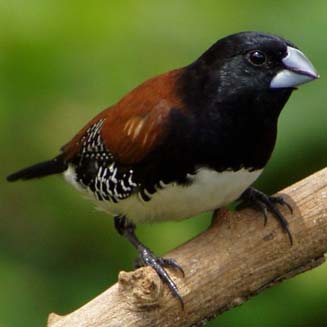|
Spermestes bicolor (Red-backed
mannikin)
Rooirugfret [Afrikaans]; Rijajani (generic term for
mannikin) [Tsonga]; Glansekstertje [Dutch]; Capucin à dos brun [French];
Glanzelsterchen [German]; Freirinha-de-dorso-vermelho [Portuguese]
Life
> Eukaryotes >
Opisthokonta
> Metazoa (animals) >
Bilateria >
Deuterostomia > Chordata >
Craniata > Vertebrata (vertebrates) > Gnathostomata (jawed
vertebrates) > Teleostomi (teleost fish) > Osteichthyes (bony fish) > Class:
Sarcopterygii (lobe-finned
fish) > Stegocephalia (terrestrial
vertebrates) > Tetrapoda
(four-legged vertebrates) > Reptiliomorpha > Amniota >
Reptilia (reptiles) >
Romeriida > Diapsida > Archosauromorpha > Archosauria >
Dinosauria
(dinosaurs) > Saurischia > Theropoda (bipedal predatory dinosaurs) >
Coelurosauria > Maniraptora >Aves
(birds) > Order: Passeriformes
> Family: Estrildidae
 |
 |
|
Red-backed mannikin adult (left) and immature
(right), Pietermaritzburg, South Africa. [photo Alan Manson
©] |
For information about this species, see
www.birdforum.net/opus/Lonchura_nigriceps Distribution and habitat
Occurs in patches from southern Somalia through Kenya,
Tanzania, eastern Zambia and Malawi to southern Africa. Here it is locally
common in Mozambique, northern and eastern Zimbabwe, Swaziland and eastern South
Africa, generally preferring riparian forest, dense thickets, edges of coastal
and lowland forest, well developed woodland and sometimes borders between pine (Pinus)
plantations and other vegetation.
|
 |
|
Distribution of Red-backed mannikin in southern
Africa, based on statistical smoothing of the records from first SA Bird
Atlas Project (©
Animal Demography unit, University of
Cape Town; smoothing by Birgit Erni and Francesca Little). Colours range
from dark blue (most common) through to yellow (least common).
See here for the latest distribution
from the SABAP2. |
Predators and parasites
It has been recorded as prey of the following animals:
Food
It mainly eats grass seeds supplemented with arthropods and
nectar, doing most of its foraging on the ground and on grass inflorescences,
often in along with other seed eating birds (such as
Common waxbill and
Bronze mannikin). The following food
items have been recorded in its diet:
- Plants
- grass seeds
- Panicum maximum (Guinea grass)
- Eleusine indica (Goose grass)
- Echinochloa pyramidalis (Limpopo grass)
- Melitis repens (Natal red top)
- Digitaria sanguinalis (Crab finger grass)
- Digitaria gazensis
- Hyparrhenia hirta (Common thatching grass)
- Setaria homonyma (Fan-leaved bristle grass)
- Setaria pallide-fusca (Garden bristle grass)
- Poa trivialis (Roughstalk bluegrass)
- Phalaris minor (Small canary grass)
- Chloris guyana (Rhodes grass)
- rice
- petals of Schotia brachypetala (Weeping boerbean)
- nectar
- Arthropods
Breeding
- The nest is an oval ball with a side entrance, usually made of grass but
occasionally it uses old-man's-beard lichen (Usnea) or wild asparagus
(Asparagus) instead. The interior is lined with soft seeding grasses
and feathers and it is typically placed in a tree, bush or patch of reeds.
- Egg-laying season is from October-May, peaking from about March-May.
- It lays 2-7 eggs, which are incubated by both sexes for about 12-13 days
(recorded in captivity)
- The chicks are fed by both parents on a diet of mainly arthropods,
leaving the nest after about 17 days (also recorded in captivity).
Threats
Not threatened, although urban development along South
Africa's east coast is reducing habitat availability.
References
-
Hockey PAR, Dean WRJ and Ryan PG 2005. Roberts
- Birds of southern Africa, VIIth ed. The Trustees of the John Voelcker
Bird Book Fund, Cape Town.
|
